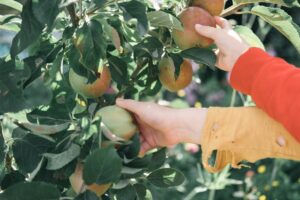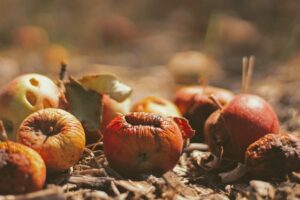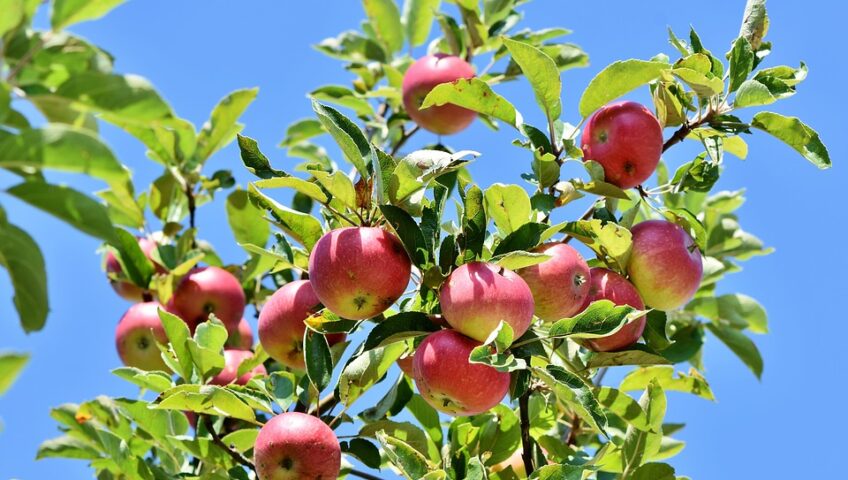There’s nothing quite like a long Minnesota autumn season filled with 60 degree days and multiple trips to the apple orchard. It’s a staple of our season, and one that never gets old.
Whether you’ve been going to an apple orchard for as long as you can remember or you simply reap the benefits of someone else’s trip, you know just how good and crisp a Minnesota-grown apple is. As the apple season comes along, many in the state wait anxiously for the highly coveted Honeycrisp, SweeTango and First Kiss apples to hit the fruit stands and grocery stores.
While going to an apple orchard to pick one of these tasty apples is an incredible fall-time activity, having your own apple trees can also be an amazing experience.
Growing Your Own Apple Trees
As we continue serving Twin Cities residents with high quality tree care services, we have been seeing an increased number of clients beginning to grow their own apple trees. While it remains easy to go to the local grocery store to buy apples, there’s just something about growing your own apples that has a unique appeal.
From August until the cool temperatures of October arrive, those with apple trees can experience the amazing opportunity of going outside their home to the nearby apple tree and picking off a sweet afternoon treat. Though this is an amazing benefit itself, apple trees include many more benefits!
Benefits Of Apple Trees
Yes, apple trees provide incredible sweet treats during the late-summer and fall seasons, but they also have many other benefits. Here are just three of them!
- Healthy Bee Population: Having apple trees on your property will promote a healthy bee population because of their work in pollination. Since apple trees need cross-pollination in order to ensure genetic diversity, it’s important to remember to plant different trees next to each other.
 Care For Nature: If you have an apple tree on your property, this will require a certain work to maintain the tree and keep it healthy and producing. Especially if you have children, this will teach them the importance of taking care of the nature around them – making sure the tree get enough water, is pruned, picked and protected.
Care For Nature: If you have an apple tree on your property, this will require a certain work to maintain the tree and keep it healthy and producing. Especially if you have children, this will teach them the importance of taking care of the nature around them – making sure the tree get enough water, is pruned, picked and protected.- Healthy Snacks: Lastly, you will have the opportunity to always have a healthy snack option close to you. You no longer need to dig through your pantry to find a sweet treat, but instead, you have a sweet-treat-producing apple tree outside that you can pick from at any time.
Growing Healthy Apple Trees
Now that we’ve talked a little bit about the benefits of having an apple tree on your property, it’s time to share some helpful tips regarding making sure your tree grows healthy and maintains its fruit-producing capabilities.
Here are 3 tips to growing healthy apple trees:
1. Water Your Apple Tree Regularly
While caring for apple trees may differ depending on the age of the tree, it’s important to make sure it receives regular watering, whether it be from rainfall or irrigation. If you’re planting a new tree, watering regularly will help make sure the root system develops properly and has a solid base from which to grow. For mature trees, the University of Minnesota Extension suggests the tree receives about one inch of watering weekly during its primary growing/producing season (May-October).
2. Protect The Tree
 Having apple trees in your yard brings many benefits, but it also takes some work to make sure the tree stays healthy over the course of its life. One way to ensure its long life is to protect it from insects and ground animals such as rabbits and deer. Bugs of all kinds love apple trees because of the fruit it produces. Whether its Apple Maggots, Codling Moths, Japanese Beetles or any other insect, these bugs can bore into the apple and destroy it.
Having apple trees in your yard brings many benefits, but it also takes some work to make sure the tree stays healthy over the course of its life. One way to ensure its long life is to protect it from insects and ground animals such as rabbits and deer. Bugs of all kinds love apple trees because of the fruit it produces. Whether its Apple Maggots, Codling Moths, Japanese Beetles or any other insect, these bugs can bore into the apple and destroy it.
To protect against these critters, you can spray insecticide on the tree, but be careful about what kind you’re using. You don’t want to affect or kill the pollinators that benefit the tree. To avoid this situation, use horticulture oil to get rid of the insects and any eggs they lay. Also, make sure to perform this in the evening or night to prevent any negative situations with the pollinators in the area.
Other threats to protect the tree from are various ground animals. Many times, deer will eat the low hanging younger shoots of the tree and consequently destroy the young branches. They will also eat the leaves and main trunk because they smell the sweetness that lies underneath. This is what other animals such as rabbits do as well. They will oftentimes eat the bark around the entire circumference of the tree and girdle it.
To protect against these animals, you can use a tree guard that wraps around the trunk of the tree, but doesn’t harm it. Another strategy you can use is fencing to keep the animals away from the entire tree area.
3. Prune The Branches
Lastly, it’s important to prune the apple tree branches in order to make sure it grows with a strong structure and can have healthy fruit production. In addition to these benefits, pruning your apple tree will allow more sunlight and air circulation to enter the innermost branches of the tree which will help produce a more evenly balanced fruit distribution.
Pruning your apple tree is a very good thing to do, but it’s extremely important to do this at the correct time. In order to not negatively affect the tree and its fruit production, it’s best to prune during the winter or very early spring months. By pruning your tree in the colder months, your tree will have a chance to properly heal before the warm weather insects arrive and attempt to enter the tree.
Apple Tree Pruning Services
Apple trees are amazing additions to homes and their surrounding properties. Not only can they benefit the environment around them, but they can be great additions to your family. If you’re needing assistance with your apple tree care or apple tree pruning, contact the tree care experts at Pro-Tree Outdoor Services today!


Write a Comment